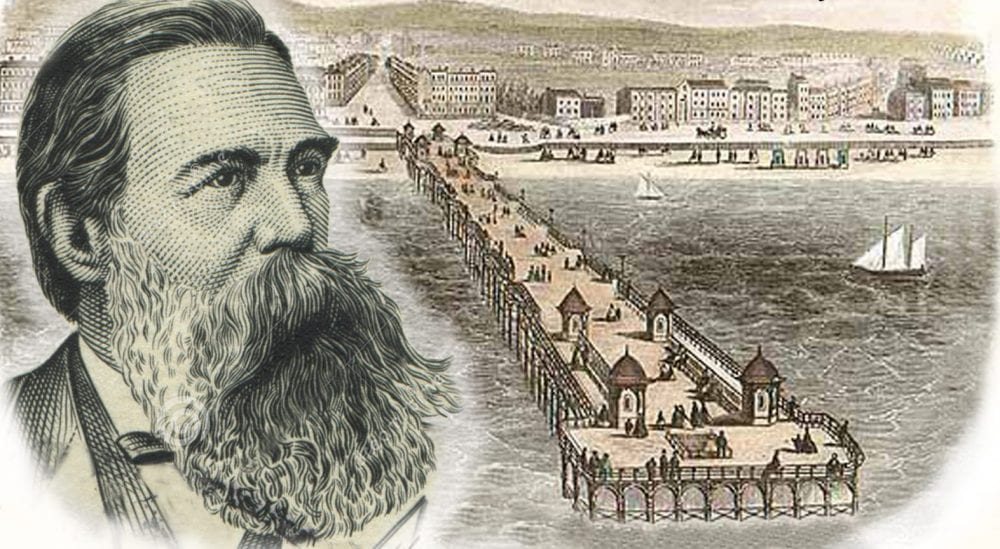[This article by Hymie Fagan (1903-1988) entitled ‘Engels in Eastbourne’ was first published in Visual History in August 1975 and is reproduced here with the kind permission of Terry Mccarthy.]
Eastbourne is often regarded as the acme of respectability – a sort of Kensington-by-the-Sea. Much of it belongs to the Duke of Devonshire and the family has imposed a sort of hall-mark on it, for it is one of the safer of Tory seats. Nevertheless, despite its somewhat aristocratic air it has a better claim to fame than its link with the Devonshires.
It was the favourite seaside resort of Frederick Engels. Marx and his wife Jenny also favoured it and they both stayed at No. 43 Terminus Road in July 1881 a few months before Jenny’s death. Engels was so fond of Eastbourne that whenever he had a few moments to spare he hurried down, usually accompanied by a member of Marx’s family or some other close friend.
Time and again he returned to his favourite Astor House, which still stands at No. 4 Cavendish Place, ‘near to the Promenade and opposite to the pier’, he wrote to Laura Lafargue, the second daughter of Karl Marx, in a letter dated August 19, 1883.
In August 1887 he went down to Astor House accompanied by Helen Demuth, who had been housekeeper to the Marx family for so many years. When Marx died and the family broke up, she took over the household of Engels and cherished the old man as she had done the Marx family.
At times he was accompanied by the niece of his common-law wife, Mary Burns. Pumps, as he nick-named the niece, came with her two children of whom Engels was very fond.
‘The whole party is returning to lunch’, he wrote to Laura, then living in France, ‘and the children want me to make them paper boats, so that’s an end to writing’.
His favourite walk was along the sea-front and over the downs to Beachy Head, high over the Channel. Here he would stand looking towards the Continent and enjoying the magnificent views of both sea and downs.
When Astor House was not available, he stayed at another charming house, Regency Villa, on Marine Parade, facing the sea. This house too is still standing and from it one has a sweeping view of the sea right over to Hastings on the one side and Beachy Head on the other.
On July 20 1893 Engels wrote to Lafargue (Marx’s son-in-law), ‘Tomorrow Louise (the divorced wife of Karl Kautsky, the famous German social-democrat) and I are going for a week to Eastbourne (address as before, 28 Marine Parade) as I need to regain a little strength before my journey to Germany … we leave Eastbourne on Friday July 28 … to travel to the Continent to meet Bebel’.
Although Engels was on friendly terms with such early socialists as Tom Mann, Will Thorne, John Burns, Keir Hardie, Harry Quelch (Social Democratic Federation) and William Morris, there is no record of their having visited Engels at Eastbourne, although they visited him at his London home in Regents Park Road.
As he grew older and more sick – towards the end he suffered from cancer of the throat from which he died – so he sought the peace of Eastbourne more frequently. Between the years 1893 and 1894 he went down several times and on November 14 1894 during a period of intense pain, he added a codicil to his will to the effect that his body should be cremated and his ashes thrown into the sea at Eastbourne.
The last letter written by Engels was from Eastbourne. Dated July 23 1895 it was addressed to Laura Lafargue and at the end of the letter he wrote ‘I do not have the strength to write long letters, so keep well’. The next day he returned to London and died on August 5.
Engels who loathed ceremony and hero-worship above all else, had directed that his funeral should be private with only his closest personal friends present. The urn containing his ashes was dropped into the sea five miles off Beachy Head, on August 27. Eleanor Marx, Edward Aveling, Edward Bernstein and Frederick Lessner were in the boat. The sea was very stormy.
It was at Heathfield, a few miles outside Eastbourne, that Jack Cade, leader of the 1450 uprising against Henry VI, was finally captured by Sherriff Iden. The spot is marked by a seat in Cade Street, surmounted by a tablet giving a vicious account of Cade.
The great English radical Tom Paine, author of The Rights of Man, lived in Lewes near Eastbourne. Paine was a customs officer in Lewes and his house still stands near to Lewes Castle, and is well worth a visit. And Shelley was born not far away from there.
